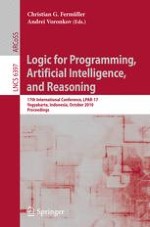2010 | Buch
Logic for Programming, Artificial Intelligence, and Reasoning
17th International Conference, LPAR-17, Yogyakarta, Indonesia, October 10-15, 2010. Proceedings
herausgegeben von: Christian G. Fermüller, Andrei Voronkov
Verlag: Springer Berlin Heidelberg
Buchreihe : Lecture Notes in Computer Science
